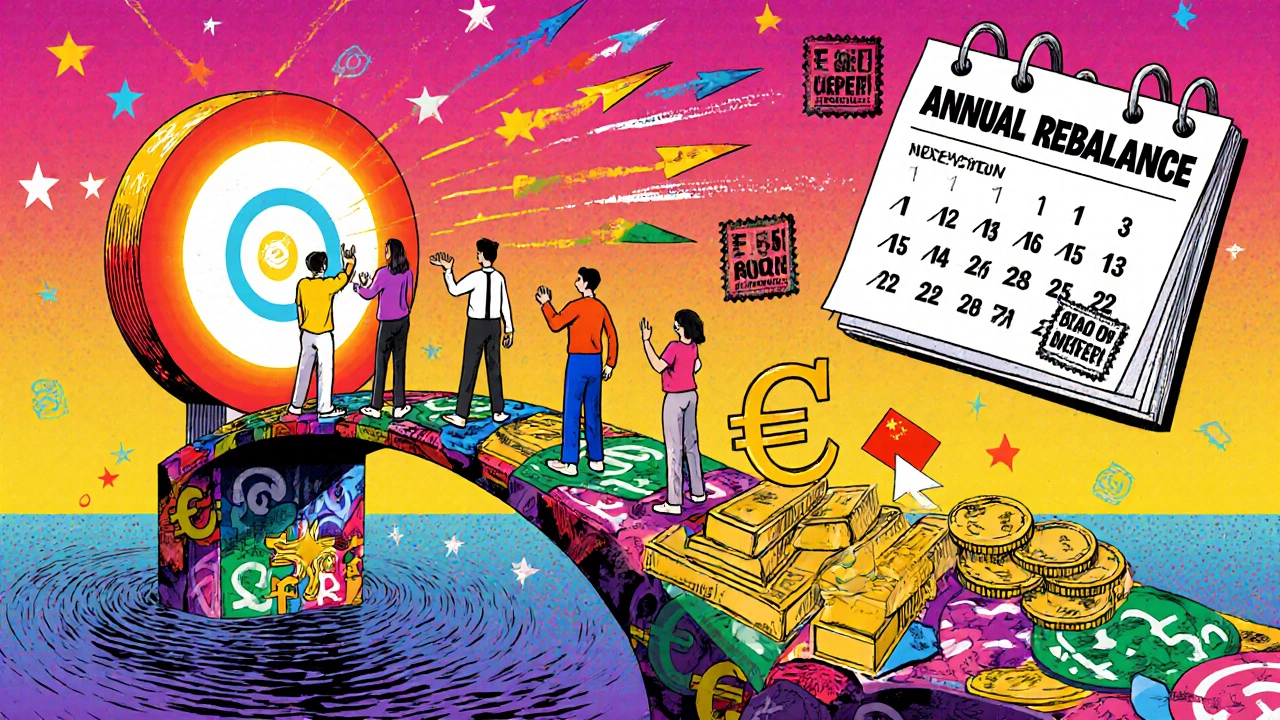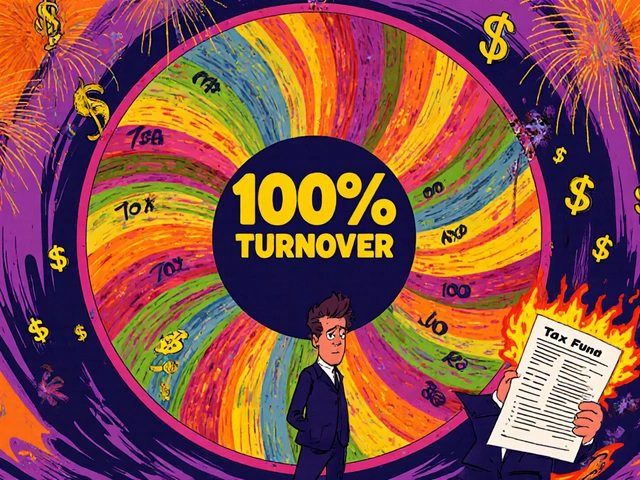International Portfolio Rebalancing Calculator
Portfolio Allocation Calculator
Check if your international portfolio needs rebalancing based on the latest currency movements and allocation rules from the article.
Recent currency movements:
Rebalancing Recommendation
For years, the rule of thumb was simple: hold most of your international investments in US dollars. The dollar was the world’s anchor - stable, liquid, and always in demand when markets got shaky. But that’s changed. In 2025, the global financial system is actively rebalancing, and investors who ignore it are leaving money on the table - or worse, exposed to hidden risks.
The international rebalancing isn’t a flash in the pan. It’s structural. The US dollar’s share of global foreign exchange reserves has dropped from 66% in 2015 to 58% in early 2025, according to the US Treasury Department. Central banks, especially in China and other emerging markets, are quietly shifting away from dollars after seeing how easily US sanctions froze Russia’s reserves in 2022. This isn’t about dumping US assets. It’s about spreading risk. And that changes everything for how you manage your portfolio.
When Should You Rebalance Your International Holdings?
There’s no magic number. Rebalancing too often - monthly or even quarterly - just eats up returns through fees and taxes. Too rarely, and you’re riding a wave that could break under you.
Most institutional investors now rebalance on a semi-annual or annual basis, but with triggers. The best approach? Combine timing with signals.
- Rebalance if your non-US allocation shifts more than ±5% from your target
- Rebalance after major currency moves - like a 5%+ swing in the euro or yen against the dollar
- Rebalance when central bank reserve data updates (released quarterly by IMF and BIS)
For example, in April 2025, the dollar dropped 5.1% against major currencies in just six weeks. That wasn’t random. It was tied to rising US import tariffs, falling tech leadership, and a surge in European bond issuance. Investors who waited for the next quarterly review missed the chance to lock in gains in euros and yen. Those who acted fast - based on the BIS data showing dollar weakness during Asian trading hours - adjusted positions before the market priced it in.
Don’t wait for headlines. Watch the data. The IMF updates global current account balances every quarter. In Q1 2025, the US deficit hit 4.1% of GDP - the widest since 2008. Meanwhile, China’s surplus jumped to 2.7%. That’s a red flag: the US is borrowing more from the world. That pressure eventually shows up in the dollar’s value. If your portfolio is 70% US stocks and 30% foreign, you’re overexposed to this imbalance. Rebalancing brings you back to your plan - not your fear.
Why Currency Moves Are No Longer Just Noise
Currency fluctuations used to be background static. Now they’re the main story.
The euro appreciated 5.3% against the dollar between December 2024 and May 2025. Why? Germany’s €500 billion infrastructure package boosted confidence in European fiscal policy. Bunds became more liquid - up 22% in trading volume year-over-year. Suddenly, European bonds weren’t just safe. They were attractive. And investors noticed.
Meanwhile, the dollar didn’t act like a safe haven in March 2025. When markets panicked over new tariffs, the dollar fell 2.3%. Historically, it would have risen 3.5%. That’s a signal. The old logic - “buy dollars when the world is scared” - is broken.
Why? Three reasons:
- Fiscal imbalance: The US is running a 6.8% deficit of GDP in 2025 - the highest in decades. More debt means more pressure on the dollar.
- Geopolitical distrust: After Russia’s reserves were frozen, countries like Saudi Arabia, Brazil, and India are holding more gold and local currency reserves. Gold purchases hit $127 billion in 2024 - a record.
- Competition in tech: Chinese AI models are now outperforming US ones in key areas. That’s eroding the “tech premium” that used to justify high US stock valuations.
So when the dollar drops, it’s not because investors are fleeing US stocks. It’s because they’re moving money to alternatives. The BIS found that 68% of dollar depreciation happened during Asian trading hours - meaning foreign investors were hedging their dollar holdings, not selling US Treasuries. That’s critical. It means the dollar’s weakness is a global portfolio shift, not a US crisis.

The Three Currency Blocs Shaping Your Portfolio
Today’s global system isn’t ruled by one currency. It’s split into three blocs:
| Bloc | Reserve Share | Key Drivers | Risk Factors |
|---|---|---|---|
| US Dollar | 58% | Liquidity, deep markets, stable institutions | Fiscal deficits, trade tensions, tech slowdown |
| Euro | 20.5% | German fiscal stimulus, rising Bund liquidity, ECB policy | Political fragmentation, energy dependency |
| Alternatives (Gold, CNY, EM currencies) | 21.5% | Central bank diversification, gold buying, regional trade deals | Liquidity gaps, political risk, regulatory opacity |
Gold is no longer just a hedge. It’s becoming a reserve asset. The World Gold Council says central banks bought $127 billion in gold in 2024 - the most ever. That’s not a trend. It’s a structural shift. If your portfolio still treats gold as “optional,” you’re not seeing the full picture.
Emerging market currencies are also holding up better than before. In April 2025, during a global market dip, the MSCI EM Currency Index fell only 1.8%. Historically, it would have dropped nearly 5%. Why? Countries are building stronger foreign reserves, reducing dollar dependency, and trading more in local currencies. India, Brazil, and Indonesia are now trading oil, wheat, and electronics without using the dollar. That’s huge.
How Institutional Investors Are Adjusting
Big players aren’t guessing. They’re measuring.
State Street’s Q1 2025 survey found 63% of global asset allocators increased non-US equity allocations in early 2025. Of those, 42% put the biggest increases into European equities. Why? Because European companies are now growing faster than US ones in key sectors like green tech and industrial automation.
At the same time, hedge funds and pension plans are using FX derivatives more than ever. Bloomberg’s April 2025 survey showed 78% of institutional investors expanded their currency hedging programs since January. They’re not betting on currencies anymore - they’re protecting against them.
Even the “TINA” (There Is No Alternative) argument is fading. Investors used to say: “Why go outside the US? Everything else is worse.” Now, they’re asking: “Where are the real growth opportunities?” And the answer isn’t just Silicon Valley anymore. It’s Berlin, Seoul, and even Jakarta.

What You Should Do Right Now
Here’s what works in 2025:
- Set a target allocation. If you’re targeting 30% international exposure, stick to it. Don’t let a strong dollar or a weak euro push you off course.
- Rebalance annually, with triggers. Check your portfolio every six months. If any currency moves more than 5%, adjust.
- Include gold. Even 3-5% in physical gold or gold ETFs adds resilience. It’s not speculative - it’s insurance.
- Watch the IMF and BIS reports. They’re the only sources that track global imbalances and reserve shifts. You don’t need to read them all - just the executive summaries released in April and July.
- Don’t panic over short-term moves. The dollar’s 5.1% drop in April 2025 wasn’t a crash. It was a correction. Markets are adjusting, not collapsing.
And if you’re still holding 80% of your international assets in US dollars? You’re not diversified. You’re exposed.
What’s Next? The Big Uncertainty
The biggest risk isn’t the dollar falling. It’s that countries respond to imbalances by building walls.
The IMF warns that rising global imbalances could lead to more trade barriers. The US Treasury is already monitoring “non-traditional” currency manipulation - meaning they’re watching for things like digital yuan usage or gold swaps. If the US slaps new tariffs or sanctions, it could trigger a new wave of currency moves.
Goldman Sachs projects the dollar’s reserve share could fall to 52-54% by 2030. That’s not doom. It’s normalization. The world is becoming multipolar. Your portfolio should be too.
The goal isn’t to bet against the dollar. It’s to stop betting everything on it.
How often should I rebalance my international portfolio in 2025?
Most investors should rebalance annually, but use triggers: if your non-US allocation shifts more than ±5% from your target, or if a major currency (like the euro or yen) moves 5% or more against the dollar in a short period. Quarterly reviews are useful for tracking data, but actual portfolio adjustments should be deliberate - not reactive.
Why is the US dollar weakening even when markets are scared?
Traditionally, the dollar rose during global turmoil because investors saw it as safe. In 2025, that’s changed. The dollar weakened during the March 2025 market dip because investors are no longer relying on it as the only safe asset. They’re moving to euros, gold, and emerging market currencies due to US fiscal deficits, geopolitical distrust, and better alternatives. The dollar’s weakness is structural, not temporary.
Should I buy gold as part of my international portfolio?
Yes - but not as a speculative bet. Central banks bought $127 billion in gold in 2024, the highest on record. Gold is now a reserve asset, not just a hedge. Adding 3-5% of your portfolio to physical gold or a low-cost gold ETF improves resilience without adding high volatility. It’s insurance against currency instability.
Is the euro a better investment than the US dollar now?
The euro isn’t “better” - it’s more attractive than it was. Germany’s €500 billion infrastructure plan and rising liquidity in German bonds made them appealing in early 2025. But the euro still carries political and energy risks. The best approach is diversification: hold euros, not just dollars. A 15-20% allocation to euro-denominated assets is now standard for balanced global portfolios.
What data should I track to know when rebalancing is needed?
Focus on three sources: 1) The IMF’s quarterly Global Financial Stability Report for global current account balances; 2) The BIS Bulletin for currency hedging trends and dollar movement patterns; 3) The US Treasury’s semi-annual FX Report for reserve share changes. You don’t need to read all of it - just the executive summaries. Watch for shifts in the US deficit, dollar reserve share, and gold purchases by central banks.






Comments
Been following this shift since last year - my portfolio shifted 10% into gold ETFs after seeing India’s central bank quietly add 12 tons in Q4. No big fanfare, but the data’s clear: everyone’s hedging. Dollar’s not dead, but it’s no longer the only safe house. I’m sticking to 5% gold, 20% euro assets, and letting the rest ride. No need to panic, just adjust.
Thank you for this. I’ve been hesitant to touch my international holdings because I didn’t want to overtrade, but this breakdown makes sense. I’ve been watching the BIS reports monthly - just the summaries - and noticed the Asian trading hour dips. Didn’t realize that was a signal until now. Adjusted my euro allocation last week. Not a huge move, but it feels more intentional. Also, 3% gold? Done. It’s like having a seatbelt for your portfolio.
Oh please. You’re all acting like this is some groundbreaking revelation. The dollar’s been in a slow-motion death spiral since 2020 - anyone with half a brain and a Bloomberg terminal saw this coming. Gold? Please. It’s just a 5,000-year-old rock that doesn’t pay interest. And calling the euro ‘attractive’? Please. Germany’s still one tweet away from a coalition collapse, and you’re allocating 20% to that? You’re not diversified - you’re just chasing the latest Wall Street meme dressed up as ‘structural rebalancing.’ If you want real alpha, go long Indonesian palm oil futures and short USTs. But no, you’d rather play it safe with ETFs and emoticons. Pathetic.